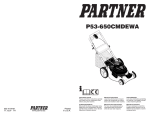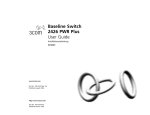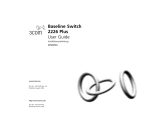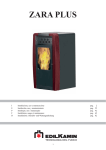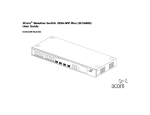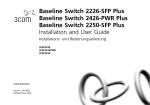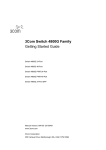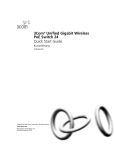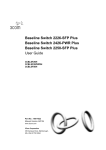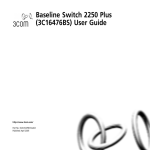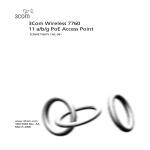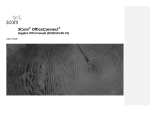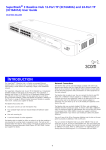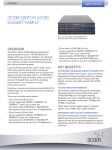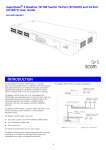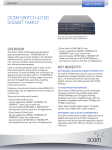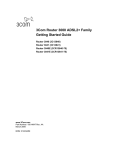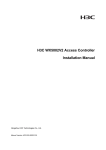Download 3Com® Baseline Switch 2816-SFP/2824-SFP Plus
Transcript
Baseline Switch 2816-SFP/2824-SFP Plus User Guide 3C Number: 3C16485A/3C16487 www.3com.com Part No. DUA1648-5AAA03 Published August 2005 3Com Corporation • 350 Campus Drive • Marlborough • MA USA 01752-3064 Copyright © 2004-2005, 3Com Corporation. All rights reserved. No part of this documentation may be reproduced in any form or by any means or used to make any derivative work (such as translation, transformation, or adaptation) without written permission from 3Com Corporation. 3Com Corporation reserves the right to revise this documentation and to make changes in content from time to time without obligation on the part of 3Com Corporation to provide notification of such revision or change. 3Com Corporation provides this documentation without warranty, term, or condition of any kind, either implied or expressed, including, but not limited to, the implied warranties, terms or conditions of merchantability, satisfactory quality, and fitness for a particular purpose. 3Com may make improvements or changes in the product(s) and/or the program(s) described in this documentation at any time. If there is any software on removable media described in this documentation, it is furnished under a license agreement included with the product as a separate document, in the hard copy documentation, or on the removable media in a directory file named LICENSE.TXT or !LICENSE.TXT. If you are unable to locate a copy, please contact 3Com and a copy will be provided to you. UNITED STATES GOVERNMENT LEGEND If you are a United States government agency, then this documentation and the software described herein are provided to you subject to the following: All technical data and computer software are commercial in nature and developed solely at private expense. Software is delivered as “Commercial Computer Software” as defined in DFARS 252.227-7014 (June 1995) or as a “commercial item” as defined in FAR 2.101(a) and as such is provided with only such rights as are provided in 3Com’s standard commercial license for the Software. Technical data is provided with limited rights only as provided in DFAR 252.227-7015 (Nov 1995) or FAR 52.227-14 (June 1987), whichever is applicable. You agree not to remove or deface any portion of any legend provided on any licensed program or documentation contained in, or delivered to you in conjunction with, this User Guide. Unless otherwise indicated, 3Com registered trademarks are registered in the United States and may or may not be registered in other countries. 3Com and the 3Com logo are registered trademarks of 3Com Corporation. Microsoft, MS-DOS, Windows, and Windows NT are registered trademarks of Microsoft Corporation. IEEE and 802 are registered trademarks of the Institute of Electrical and Electronics Engineers, Inc. Netscape Navigator is a registered trademark of Netscape Communications. JavaScript is a trademark of Sun Microsystems. All other company and product names may be trademarks of the respective companies with which they are associated. ENVIRONMENTAL STATEMENT It is the policy of 3Com Corporation to be environmentally-friendly in all operations. To uphold our policy, we are committed to: ■ Establishing environmental performance standards that comply with national legislation and regulations. ■ Conserving energy, materials and natural resources in all operations. ■ Reducing the waste generated by all operations. Ensuring that all waste conforms to recognized environmental standards. Maximizing the recyclable and reusable content of all products. ■ Ensuring that all products can be recycled, reused and disposed of safely. ■ Ensuring that all products are labelled according to recognized environmental standards. ■ Improving our environmental record on a continual basis. End of Life Statement 3Com processes allow for the recovery, reclamation and safe disposal of all end-of-life electronic components. Regulated Materials Statement 3Com products do not contain any hazardous or ozone-depleting material. Environmental Statement about the Documentation The documentation for this product is printed on paper that comes from sustainable, managed forests; it is fully biodegradable and recyclable, and is completely chlorine-free. The varnish is environmentally-friendly, and the inks are vegetable-based with a low heavy-metal content. CONTENTS Placing Units On Top of Each Other 15 Supplying Power to the Switch 16 Checking for Correct Operation 16 Connecting a Network Device 17 Using SFP Transceivers 18 Approved SFP Transceivers 18 Inserting an SFP Transceiver 18 Removing an SFP Transceiver 19 Performing Spot Checks 19 ABOUT THIS GUIDE Naming Convention 5 Conventions 5 Related Documentation 6 Documentation Comments 6 Product Registration 6 1 INTRODUCING THE BASELINE SWITCH Overview of the Baseline Switch 7 Features and Capabilities 7 Autosensing of MDI/MDIX Connections 7 Autonegotiating 10/100/1000 Mbps Ports 7 SFP Ports 7 Physical Features 8 Front Panel 8 Rear Panel 11 Package Contents 11 2 3 Requirements for Accessing the Web Interface 21 Running the Discovery Application 21 Logging On to the Web Interface 22 Navigating Around the Web Interface 23 Menu 23 Buttons 24 Device Mimic 24 Accessing the Interface Without Using Discovery 25 DHCP Assigned IP Address 25 Manually Assigned (Static) IP Address 25 INSTALLING THE SWITCH Before You Begin 13 Positioning the Switch 13 Rack-Mounting or Free-Standing 14 Using the Mounting Kit 14 Montagesatz Anweisungen 15 CONNECTING TO THE WEB INTERFACE 4 CONFIGURING THE SWITCH Configuration Overview 27 Viewing Switch Information 27 Changing the Admin Password 28 Modifying the IP Address Settings 29 Automatic IP Configuration 29 Setting the IP Address 30 Configuring Port Settings 31 Basic Port Configuration 31 Advanced Port Configuration 33 Configuring VLANs 33 Creating a VLAN 34 Sample VLAN Configurations 35 Removing a VLAN 37 Configuring Link Aggregation 37 Guidelines for Creating Aggregated Links 38 Defining the Members of an Aggregated Link 38 Modifying Settings and Deleting an Aggregated Link 39 Viewing the Trunk Summary 39 Viewing Statistics 40 Mirroring Port Traffic 41 Running Cable Diagnostic 42 Using the System Tools 42 Restart 42 Configuration 43 Resetting to Factory Defaults 43 Backing Up and Restoring Configuration 44 Upgrade 44 Spanning Tree 45 802.1p Prioritization 46 Viewing Support Information 47 5 Forgotten Static IP Address Solving LED Issues 49 If the Problem Persists 52 A OBTAINING SUPPORT FOR YOUR PRODUCT Register Your Product 53 Purchase Value-Added Services 53 Troubleshoot Online 53 Access Software Downloads 53 Telephone Technical Support and Repair Contact Us 54 B TECHNICAL INFORMATION Related Standards Environmental Physical 57 Electrical 57 C 57 57 SAFETY INFORMATION Important Safety Information 59 L'Information De Sécurité Importante 60 Wichtige Sicherheitinformationen 61 GLOSSARY REGULATORY NOTICES TROUBLESHOOTING Forgotten Password 49 49 INDEX 54 ABOUT THIS GUIDE This guide is intended for use by those responsible for installing and setting up network equipment. Consequently, it assumes a basic working knowledge of local area networks (LANs). If a release note is shipped with this 3Com Baseline Switch 2816-SFP/2824-SFP Plus and contains information that differs from the information in this guide, follow the information in the release note. Conventions Table 1 and Table 2 list conventions that are used throughout this guide. Table 1 Icon Most user guides and release notes are available in Adobe Acrobat Reader Portable Document Format (PDF) on the 3Com World Wide Web site: www.3com.com Naming Convention Throughout this guide, the 3Com Baseline Switch 2816/2824-SFP Plus is referred to as the Switch. Category 3 and Category 5 Twisted Pair Cables are referred to as Twisted Pair Cables throughout this guide. Notice Icons Notice Type Description Information note Information that describes important features or instructions Caution Information that alerts you to potential loss of data or potential damage to an application, system, or device Warning Information that alerts you to potential personal injury Table 2 Text Conventions Convention Description The words “enter” and “type” When you see the word “enter” in this guide, you must type something, and then press Return or Enter. Do not press Return or Enter when an instruction simply says “type.” Keyboard key names If you must press two or more keys simultaneously, the key names are linked with a plus sign (+). Example: Press Ctrl+Alt+Del 6 ABOUT THIS GUIDE Table 2 Text Conventions (continued) Convention Description Words in italics Italics are used to: ■ Emphasize a point. ■ Denote a new term at the place where it is defined in the text. ■ Identify menu names, menu commands, and software button names. Examples: From the Help menu, select Contents. Click OK. Related Documentation In addition to this guide, each 3Com Baseline Switch 2816-SFP/2824-SFP Plus documentation set includes the following: ■ Online Help – Accessible from the Web interface, provides information that helps you perform tasks using the Web interface. ■ Release Notes – Provide information about the current software release, including new features, modifications, and known problems. Documentation Comments Your suggestions are very important to us. They will help make our documentation more useful to you. Please e-mail comments about this document to 3Com at: [email protected] Please include the following information when commenting: ■ Document title ■ Document part number (on the title page) ■ Page number (if appropriate) Example: ■ 3Com Baseline Switch 2816-SFP/2824-SFP Plus User Guide ■ Part Number DUA1648-5AAA03 ■ Page 24 Do not use this e-mail address for technical support questions. For information about contacting Technical Support, please refer to “Viewing Support Information” on page 47. The Switch is part of the extensive Baseline range of 3Com products. This range includes hubs, switches, power systems and other networking equipment, and is continually being developed. Contact your supplier for the latest product information and to order these products. Product Registration You can now register your Baseline Switch on the 3Com Web site to receive up-to-date information on your product: 1 INTRODUCING THE BASELINE SWITCH This chapter provides an overview of the features and capabilities of the 3Com® Baseline Switch 2816/2824-SFP Plus. It also identifies the contents of the Switch package and helps you get to know the physical features of the device. Overview of the Baseline Switch The 3Com Baseline Switch 2816-SFP/2824-SFP Plus is a versatile, easy-to-use configurable Switch. It is ideal for users who want the high-speed performance of 10/100/1000 switching with the added functionality of Gigabit links, but do not need sophisticated management capabilities. The Switch is shipped ready for use. No configuration is necessary. Features and Capabilities The Switch has 16 (2816-SFP) or 24 (2824-SFP) shielded RJ-45, 10/100/1000 Mbps auto-negotiating ports and four Small Form Factor Pluggable (SFP) transceiver slots on the front panel for easy, flexible connection to fiber-based Gigabit media. Autosensing of MDI/MDIX Connections All ports on the Switch can autosense both medium dependent interface (MDI) and medium dependent interface crossover (MDIX) connections. This allows you to connect network devices to each port using either a normal straight-through TP (twisted pair) cable or a ‘crossover’ TP cable. Any port can therefore be used to connect to another switch port, server, or workstation without additional configuration. Autonegotiating 10/100/1000 Mbps Ports Each 10/100/1000 Mbps port automatically determines the speed and duplex mode of the connected equipment and provides a suitable switched connection. The 1000BASE-T ports also support automatic 10/100/1000 Mbps speed detection. 10/100 Mbps connections on these 1000BASE-T ports can operate in either half-duplex or full-duplex mode. 1000 Mbps connections, on the other hand, only operate in full duplex mode. SFP Ports The four SFP ports support fiber Gigabit Ethernet short-wave (SX) and long-wave (LX) SFP transceivers in 8 CHAPTER 1: INTRODUCING THE BASELINE SWITCH any combination. This offers you the flexibility of using SFP transceivers to provide connectivity between the Switch and a 1000 Mbps core network. When an SFP port is in operation, the corresponding 10/100/1000BASE-T port is disabled. Physical Features Figure 1 shows the front and rear panels of the Switch. The numbers in this diagram refer to numbered sections in “Front Panel” below and “Rear Panel” on page 11. Figure 1 Front and Rear Panels (2816-SFP) 1 Baseline Switch 2816-SFP Plus Module Present 1 4 5 8 9 12 13 16 8 Link/Activity : Green = 1000M, Yellow = 10/1000M, 3C16485A Flash = Activity, Duplex : On = Full, Off = Half 2 4 5 3 6 7 9 Front Panel The front panel of the Switch contains a series of indicator lights (LEDs) that help describe the state of various networking and connection operations. (1) RJ-45 10/100/1000 Ports WARNING: RJ-45 Ports. These are shielded RJ-45 data sockets. They cannot be used as standard traditional telephone sockets, or to connect the unit to a traditional PBX or public telephone network. Only connect RJ-45 data connectors, network telephony systems, or network telephones to these sockets. Either shielded or unshielded data cables with shielded or unshielded jacks can be connected to these data sockets. AVERTISSEMENT: Points d’accès RJ-45. Ceux-ci sont protégés par des prises de données. Ils ne peuvent pas être utilisés comme prises de téléphone conventionnelles standard, ni pour la connection de l’unité à un réseau téléphonique central privé ou public. Raccorder seulement connecteurs de données RJ-45, systèmes de réseaux de téléphonie ou téléphones de réseaux à ces prises. Il est possible de raccorder des câbles protégés ou non protégés avec des jacks protégés ou non protégés à ces prises de données. WARNHINWEIS: RJ-45-Porte. Diese Porte sind geschützte Datensteckdosen. Sie dürfen weder wie normale traditionelle Telefonsteckdosen noch für die Verbindung der Einheit mit einem traditionellem privatem oder öffentlichem Telefonnetzwerk gebraucht werden. Nur RJ-45-Datenanscluße, Telefonnetzsysteme or Netztelefone an diese Steckdosen anschließen. Entweder geschützte oder ungeschützte Buchsen dürfen an diese Datensteckdosen angeschlossen werden. The Switch has 16 (2816-SFP) or 24 (2824-SFP) 10/100/1000 Mbps auto-negotiating ports. Each port Physical Features 9 supports automatic MDI/MDI-X detection and can be connected to a 10BASE-T, 100BASE-TX, or a 1000BASE-T device. SFP transceivers to provide connectivity between the Switch and remote 1000 Mbps workgroups or to create a high-capacity aggregated link backbone connection. Ports 1 to 16 (2816-SFP) or ports 1 to 24 (2824-SFP) are auto-negotiating: their speed and duplex mode (half duplex or full duplex for 10BASE-T and 100BASE-TX, full duplex only for 1000BASE-T) are automatically determined by the capabilities of the connected device. SFP ports are numbered 13 to 16 (2816-SFP) and 21 to 24 (2824-SFP) on the Switch. When an SFP port is active, it has priority over the 10/100/1000 port of the same number. The corresponding 10/100/1000 port is disabled when an SFP transceiver is plugged in. CAUTION: The Switch supports full duplex auto-negotiation. If auto-negotiation is disabled for 1000BASE-T, then the Switch uses the forced-mode default of 100 full duplex mode. If the connected device does not support auto-negotiation, the Switch will operate in half duplex mode (even if the attached device is operating in full duplex mode). In such a configuration, you may notice some degradation of network performance. 3Com recommends that you use devices that are capable of auto-negotiation (and that you ensure that auto-negotiation is enabled, if it is a configurable option). (3) Link/Activity Status LEDs (2) SFP Ports The Small Form Factor Pluggable (SFP) ports are numbered 13 to 16. If an SFP transceiver (purchased separately) is installed in a slot and is active, the associated RJ-45 port of the same number is disabled. The four SFP ports support fiber Gigabit Ethernet short-wave (SX) and long-wave (LX) SFP transceivers in any combination. This offers you the flexibility of using The following table lists LEDs visible on the front of the Switch, and how to read their status according to color. Table 1 10BASE-T/100BASE-TX Ports Status Meaning Green The link is operating at 1000 Mbps. Yellow The link is operating at 10 or 100 Mbps. Flashing Green Packets are being received or transmitted on the port at 1000 Mbps. Flashing Yellow Packets are being received or transmitted on the port at 10 or 100 Mbps. 10 CHAPTER 1: INTRODUCING THE BASELINE SWITCH Table 1 10BASE-T/100BASE-TX Ports (5) Port Duplex LEDs Flashing Yellow to Green Port disabled or link loopback error. The second and fourth (bottom) row of Status LEDs, which are colored yellow, show the duplex status of the related ports. Off The link has not been established, either nothing is connected to the port, or there is a problem: ■ Check that the attached device is powered on. ■ Check that the cable or fiber is the correct type and is not faulty. ■ For fiber connections, ensure that the receive (RX) and transmit (TX) cable connectors are not swapped. If these checks do not identify the cause of the problem, it may be that the unit or the device connected to the port is faulty. Contact your supplier for further advice. Table 3 Duplex LEDs Status Meaning Off No link, not yet negotiated or the port is operating in half-duplex mode. Yellow The port is operating in full-duplex mode. (6) Power LED The Power LED shows the power status of the Switch: (4) Module Active LEDs The Module Active LEDs shows the status of any SFP modules that are installed. Table 2 Module Active LEDs Status Meaning Green Fiber SFP is inserted in the slot. Off No fiber SFP is inserted in the slot. Table 4 Power LEDs Status Meaning Green The unit is powered on and ready for use. Off ■ ■ ■ The unit is not receiving power: Check that the power cord is connected correctly. If the unit still does not operate, contact your supplier. Flashing Green ■ Power-on self test is in progress. Yellow ■ Power-on self test or loopback test failed. Switch is in failsafe mode. Package Contents 11 (7) Self-Adhesive Pads The unit is supplied with four self-adhesive rubber pads. If you intend to rack-mount the Switch, do not apply the pads. If the unit is to be part of a free-standing stack, apply the pads to each marked corner area on the underside of the unit. Place the unit on top of the lower unit, ensuring that the pads locate with the recesses of the lower unit. Rear Panel (8) Power Supply The Switch automatically adjusts to the supply voltage. Only use the power cord that is supplied with the unit. (9) Recovery button The recovery button reinitializes the Switch. This returns the Switch to the factory default settings if, for example, you have forgotten the default IP address, or forgotten your user name or password. CAUTION: 3Com recommends that you back up your configuration settings before you recover the Switch, otherwise your configuration will be lost. Refer to “Configuration” on page 43 for details. Package Contents Before installing and using the Switch, verify that your Switch package is complete. The Switch comes with: ■ One power cord ■ Four standard height, self-adhesive rubber pads ■ One mounting kit ■ 3Com Installation CD ■ This User Guide ■ Warranty flyer If any of the above items are damaged or missing, contact your 3Com network supplier immediately. 12 CHAPTER 1: INTRODUCING THE BASELINE SWITCH 2 INSTALLING THE SWITCH This chapter contains information that you need to install and set up the Switch. It covers the following topics: ■ Before You Begin ■ Positioning the Switch ■ Rack-Mounting or Free-Standing ■ Supplying Power to the Switch ■ Connecting a Network Device ■ Using SFP Transceivers ■ Performing Spot Checks Before You Begin WARNING: Safety Information. Before installing or removing any components from the Switch or carrying out any maintenance procedures, read the safety information provided in Appendix C of this guide. AVERTISSEMENT: Consignes de Sécurité. Avant d'installer ou d'enlever tout composant du Switch ou d'entamer une procédure de maintenance, lisez les informations relatives à la sécurité qui se trouvent dans l'Appendice B (Appendix C) de ce guide. WARNHINWEIS: Sicherheitsinformationen. Bevor Sie Komponenten aus dem Switch entfernen oder dem Switch hinzufuegen oder Instandhaltungsarbeiten verrichten, lesen Sie die Sicherheitsanweisungen, die in Anhang B (Appendix C) in diesem Handbuch aufgefuehrt sind. ADVERTENCIA: Información de Seguridad. Antes de instalar o extraer cualquier componente del product o de realizar tareas de mantenimiento, debe leer la información de seguridad facilitada en el Apéndice B (Appendix C) de esta guía del usuario. AVVERTENZA: Informazioni di Sicurezza. Prima di installare o rimuovere qualsiasi componente dal product o di eseguire qualsiasi procedura di manutenzione, leggere le informazioni di sicurezza riportate nell'Appendice B (Appendix C) della presente guida per l'utente. Positioning the Switch The Switch is suitable for use in an office environment where it can be free-standing or mounted in a standard 19-inch equipment rack. 14 CHAPTER 2: INSTALLING THE SWITCH Alternatively, the Switch can be rack-mounted in a wiring closet or equipment room. A mounting kit, containing two mounting brackets and four screws, is supplied with the Switch. Rack-Mounting or Free-Standing The unit can be mounted in a 19-inch equipment rack using the mounting kit or it can be free-standing. Do not place objects on top of the unit or stack. When deciding where to position the Switch, ensure that: ■ It is accessible and cables can be connected easily. ■ Cabling is away from sources of electrical noise. These include lift shafts, microwave ovens, and air conditioning units. Electromagnetic fields can interfere with the signals on copper cabling and introduce errors, therefore slowing down your network. ■ Water or moisture cannot enter the case of the unit. ■ Air flow around the unit and through the vents in the side of the case is not restricted (3Com recommends that you provide a minimum of 25 mm (1 in.) clearance). ■ The air is as free of dust as possible. ■ Temperature operating limits are not likely to be exceeded. It is recommended that the unit is installed in a clean, air conditioned environment. It is always good practice to wear an anti-static wrist strap when installing network equipment, connected to a ground point. If one is not available, try to keep in contact with a grounded rack and avoid touching the unit's ports and connectors, if possible. Static discharge can cause reliability problems in your equipment. CAUTION: If installing the Switch in a free-standing stack of different size Baseline or Superstack® 3 units, the smaller units must be installed above the larger ones. Do not have a free-standing stack of more than six units. Using the Mounting Kit The Switch is supplied with two mounting brackets and four screws. These are used for rack mounting the unit. When mounting the unit, you should take note of the guidelines given in “Positioning the Switch” on page 13. The Switch is 1U high and will fit in a standard 19-inch rack. CAUTION: Before continuing, disconnect all cables from the unit. Remove the self-adhesive pads from the underside of unit, if already fitted. To rack-mount the Switch: 1 Place the unit the right way up on a hard, flat surface with the front facing towards you. 2 Locate a mounting bracket over the mounting holes on one side of the unit. Rack-Mounting or Free-Standing 3 Der Switch ist eine Baueinheit hoch und passt in einen Standard 19'' (Zoll) Baugruppenträger. Insert the two screws supplied in the mounting kit, and the fully tighten with a suitable screwdriver. Figure 2 Baseline Switch 28 ACHTUNG: Entfernen Sie alle Kabel, bevor Sie fortfahren. Entfernen Sie die selbstklebenden Polster (Füße) von der Unterseite der Baugruppe, falls diese bereits angebracht sind. Inserting the Screws 16-SFP Plu 1 Plazieren Sie die Baugruppe aufrecht auf einer harten, ebenen Fläche mit der Vorderseite zu Ihnen. 2 Ordnen Sie eine der Halterungen über den Löchern an der Seite der Baugruppe an. 3 Stecken Sie zwei der mitgelieferten Schrauben in die Löcher und drehen Sie diese mit einem geeigneten Schraubendreher fest. 4 Widerholen Sie letzten beiden Schritte auf der anderen Seite der Baugruppe. 5 Führen Sie die Baugruppe in den 19" (Zoll) Baugruppenträger ein und sichern sie die Baugruppe mit geeigneten Schrauben. (Nicht im Lieferumfang enthalten.) 6 Schließen Sie alle Kabel wieder an. s 4 Repeat the two previous steps for the other side of the unit. 5 Insert the unit into the 19-inch rack and secure with suitable screws (not provided). 6 Reconnect the cables. 15 Placing Units On Top of Each Other Montagesatz Anweisungen Der Switch wird mit zwei Halterungen und vier Schrauben geliefert. Diese werde für den Einbau in einen Baugruppenträger benutzt. Bei der Montage der Baugruppe beachten Sie die Anweisungen aus “Positioning the Switch” on page 13. If the Switch units are free-standing, up to four units can be placed one on top of the other. If you are mixing a variety of Baseline and SuperStack units, the smaller units must be positioned at the top. If you are placing Switch units one on top of the other, you must use the self-adhesive rubber pads supplied. 16 CHAPTER 2: INSTALLING THE SWITCH To power on the Switch: Apply the pads to the underside of each Switch, sticking one in the marked area at each corner. 1 Place the Switch units on top of each other, ensuring that the pads of the upper unit line up with the recesses of the lower unit. Plug the power cord into the power socket on the rear panel of the Switch. Refer to “(8) Power Supply” on page 11 for more information. 2 Plug the other end of the power cord into a power outlet. Supplying Power to the Switch Power problems can be the cause of serious failures and downtime in your network. Ensure that the power input to your system is clean and free from sags and surges to avoid unforeseen network outages. We recommend that you install power conditioning, especially in areas prone to black outs, power dips and electrical storms. The unit is intended to be grounded. Ensure it is connected to earth ground during normal use. Installing proper grounding helps to avoid damage from lightning and power surges. Before powering on the Switch, verify that the network cables and the power cable are securely connected. CAUTION: The Switch has no ON/OFF switch. The only way to power on and power off the Switch is by connecting and disconnecting the power cord. This is called “power cycling”. When the Switch is powered on, the Power LED lights up. If the Power LED does not light up, refer to “(6) Power LED” on page 10 for more information. Checking for Correct Operation After you power on the Switch, it automatically performs a power-on self-test (POST). During POST, the Power LED on the front panel of the Switch flashes green. When POST is complete, the Power LED turns green. If the Power LED turns yellow after POST, it means that POST failed and the Switch has entered fail-safe mode. Table 5Table 5 summarizes the possible colors for the Power LED after POST. Table 5 Possible Power LED Colors After POST Color State Green The unit is powered on and ready for use Connecting a Network Device Color State Yellow Power-on self-test or loopback test failed. The Switch is in fail-safe mode. This can happen if a ports or ports fail when the Switch was powered on. Off 17 Connecting a Network Device To connect a network device to the Switch, use Category 5 unshielded or shielded (screened) 100 Ohm TP cables (or Category 3 cables for 10 Mbps connections). The unit is not receiving power: Verify that the power cord is connected correctly, and then try powering on the Switch again ■ If the Switch still does not operate, contact your 3Com network supplier ■ For optimal connections, ensure that the cable length for each connection is not longer than 100 m (328 ft). Figure 3 If POST fails, try the following: ■ Power off the Switch, and then power it on again. Check the Power LED and see if POST was successfully completed. ■ Reset the Switch. See “Resetting to Factory Defaults” on page 43. Connecting Devices to the Switch Baseline 10/100 Switch Endstations on switched 100 Mbps connections Baseline 10/100 Switch Endstations on switched 100 Mbps connections CAUTION: Resetting the Switch to its factory defaults erases all your settings. You will need to reconfigure the Switch after you reset it. Baseline Baseline Switch 2816/2824-SFP Switch 2250 Plus If these do not resolve the issue: ■ ■ Endstations on switched 100 Mbps or 1000 Mbps connections Check the 3Com Knowledgebase for a solution. To visit the 3Com Knowledgebase Web site, start your Web browser, and then enter http://knowledgebase.3com.com. Contact your 3Com network supplier for assistance. 1000 Mbps copper or F iber connection to backbone or server/worksation 1000 Mbps link 10 Mbps or 100 Mbps link To connect a device to the Switch: 1 Connect one end of the cable to an RJ-45 port on the Switch. 18 CHAPTER 2: INSTALLING THE SWITCH 2 Connect the other end to the appropriate RJ-45 port on the connecting device. Inserting an SFP Transceiver To be recognized as valid, the SFP transceiver must be one of the following: For 1000BASE-T operation, 3Com recommends using Category 5e or 6 cables. Using SFP Transceivers The following sections describe how to insert and remove an SFP transceiver from an SFP slot. SFP transceivers are hot-insertable and hot-swappable. You can remove them from and insert them into any SFP port without having to power off the Switch. ■ 3CSFP91 SFP (SX) ■ 3CSFP92 SFP (LX) To access the latest list of approved SFP transceivers for the Switch on the 3Com Corporation World Wide Web site, enter this URL into your Internet browser: www.3com.com 3Com recommends using 3Com SFPs on the Switch. If you insert an SFP transceiver that is not supported, the Switch will not recognize it. 1000BASE-SX SFP transceiver – Use this transceiver to connect the Switch directly to a multimedia fiber-optic cable. ■ 1000BASE-LX SFP transceiver – Use this transceiver to connect the Switch directly to a single-mode fiber-optic cable or to multimode fiber using a conditioned launch cable. If the SFP transceiver is faulty, it will not operate within the Switch. See “Troubleshooting” starting on page 49. Approved SFP Transceivers The following list of approved SFP transceivers is correct at the time of publication: ■ To insert an SFP transceiver: 1 Hold the transceiver so that the fiber connector is toward you and the product label is visible, as shown in Figure 4. Ensure the wire release lever is closed (in the upright position). Performing Spot Checks Figure 4 Inserting an SFP Transceiver 7 19 Check the Module Active LEDs on the front of the Switch to ensure that it is operating correctly. Removing an SFP Transceiver Product label Mod ule Removing an SFP transceiver does not require powering off the Switch. Prese nt To remove an SFP transceiver: Wire release lever Link /Ac Flas tivity : h= Act Suitable slot on host Switch 1 Disconnect the cable from the transceiver. 2 Move the wire release lever downwards until it is pointing toward you. 3 Pull the wire release lever toward you to release the catch mechanism. The SFP transceiver should slide out easily. 2 Gently slide the transceiver into the SFP slot until it clicks into place. CAUTION: SFP transceivers are keyed and can be properly inserted only one way. If the transceiver does not click when you insert it, remove it, turn it over, and then re-insert it. 3 Remove the plastic protective cover, if fitted. 4 Connect the fiber cable. 5 The transceiver connects to the network using a duplex LC connector. Attach a male duplex LC connector on the network cable into the duplex LC connector on the transceiver. 6 Connect the other end of the cable to a device fitted with an appropriate Gigabit Ethernet connection. Performing Spot Checks At frequent intervals, you should visually check the Switch. Regular checks can give you an early warning of a possible failure; any problems can then be attended to when there will be least effect on users. 3Com recommends periodically checking the items listed in Table 6. 20 CHAPTER 2: INSTALLING THE SWITCH Table 6 Items to Check Item Verify That Cabling All external cabling connections are secure and that no cables are pulled taut Cooling Fan Where possible, check that the cooling fan is operating by listening to the unit. The fan is fitted on the right side of the unit (when viewed from the front). If you experience any problems operating the Switch, refer to “Troubleshooting” on page 49. 3 CONNECTING TO THE The Switch has a built-in Web interface that you can use to set the admin password, change the IP address that is assigned to the Switch, and configure its advanced settings. WEB INTERFACE Requirements for Accessing the Web Interface To connect to the Web interface, you need the following: If you only want the Switch to function as a basic layer 2 switch, you do not need to access the Web interface and configure the Switch. This chapter provides information on how the gain access to the Web interface using the Discovery application. It also introduces the menu items and buttons that are available on the Web interface. The following topics are covered: ■ Requirements for Accessing the Web Interface ■ Running the Discovery Application ■ Logging On to the Web Interface ■ Navigating Around the Web Interface ■ Accessing the Interface Without Using Discovery ■ The Discovery application, which is included on 3Com Baseline Switch 2816-SFP/2824-SFP Plus CD-ROM that is supplied with your Switch ■ A computer that is connected to the Switch and that has a Web browser Running the Discovery Application The 3Com Baseline Switch 2816-SFP/2824-SFP Plus CD-ROM contains, among others, the Discovery application. To use Discovery to connect to the Web interface, do the following: 1 On a computer that is connected to the Switch, insert the CD-ROM into its CD drive. Discovery should start automatically. If it does not start automatically, go to the \Discovery folder on the CD-ROM, and then double-click discovery.exe. 22 CHAPTER 3: CONNECTING TO THE WEB INTERFACE The Welcome screen of Discovery appears. Figure 5 Figure 6 Welcome Screen of Discovery 3 2 Discovered Devices Screen If the computer has multiple network adapters, select the adapter that connects the computer to the Switch, and then click Next. If the computer has only one adapter, click Next. Discovery searches the network for 3Com devices. When detection is complete, the Discovered Devices screen displays detected network devices. On the Discovered Devices screen, click Baseline Switch 2816-SFP/2824-SFP Plus, and then click Next. The Completing the 3Com Discovery Application screen appears. 4 Click Finish. The Web interface loads in your Web browser. Logging On to the Web Interface After the Web interface loads in your Web browser, the first page that appears is the logon page. On this page, you need to enter the administration user name and password to gain access to the Web interface. Navigating Around the Web Interface The logon page also displays the IP address that the Switch is currently using. Figure 7 Logon Page Menu The menu is located on the left side of the Web interface. When you click an item on the menu, the related information appears in the main section of the interface. Figure 8 Web Interface Layout Main Section Buttons To log on to the Web interface: 1 In Username, type admin. 2 Leave the Password field blank. 3 Click OK. Navigating Around the Web Interface The Web interface has been designed to enable you to easily perform advanced configuration tasks and view information about the Switch. 23 Menu Device Mimic Table 7 lists the available items on the menu. 24 CHAPTER 3: CONNECTING TO THE WEB INTERFACE Table 7 Available Menu Items Menu Item Description Menu Item Description Support Summary Provides a summary of the Switch’s basic settings and versions of current components Displays 3Com contact information and describes how to use the online help system Log Out Password Allows you to change the administrator password Allows you to securely log off the Web interface IP Settings Allows you to configure the IP address settings of the Switch Port Configuration Allows you to configure the Switch’s port settings VLANs Allows you to create VLAN groups, add port members, and specify how VLAN tagging is used Link Aggregation Allows you to set up and maintain trunk membership for port groups Buttons Depending on the page that is currently displayed, the following buttons may appear: ■ Apply – Click to save and apply any changes that you have made ■ Cancel – Click to discard any unsaved changes ■ Help – Click to display the context-sensitive help information for the page that is currently displayed. The help pages provide information on the tasks that you can perform on each interface page. Port Mirroring Allows you to perform port traffic monitoring on the Switch. To monitor a port, you will also need a network analyzer. Traffic Prioritization Allows you to configure traffic prioritization for IP phones that are connected to the Switch Cable Diagnostics Allows you to detect and resolve cable issues At the bottom of each page is an image of the Switch’s front panel, which indicates ports that are currently in use. System Tools Allows you to perform various system maintenance tasks, such as upgrading the firmware, resetting the Switch, backing up and restoring configuration, and enabling 802.11p prioritization. To configure a port, click the port on the image. This takes you to the Basic Port Configuration tab, where you can: Device Mimic ■ Assign a name (or label) to the port ■ Enable or disable the port Accessing the Interface Without Using Discovery ■ Enable or disable flow control ■ Configure the speed duplex settings ■ Set traffic priority for the port 25 For example, if the DHCP server assigned the IP address 192.168.0.123 to the Switch, start your Web browser, and then type http://192.168.0.123. Manually Assigned (Static) IP Address Accessing the Interface Without Using Discovery The Discovery application works by automatically detecting the IP address that is assigned to the Switch, and then using that address to connect to the Web interface. If you know the Switch’s IP address, you can access the Web interface without using Discovery. This section describes how to access the interface directly, without using Discovery. If you do not configure the Switch’s IP address settings, it will perform auto IP configuration to assign an IP address to itself. For more information, refer to “Automatic IP Configuration” on page 29. To determine the IP address that the Switch will assign to itself during auto IP configuration, check the sticker on the base of the Switch. This sticker contains the MAC address and default IP address of the Switch. DHCP Assigned IP Address If you set the IP address mode to DHCP, check the DHCP server for the IP address that is assigned to the Switch, and then use that IP address to access the Web interface. If you assigned a static IP address to the Switch, you need to use that IP address to access the Web interface the next time you want to configure the Switch. For example, if you assigned the Switch the IP address 192.168.0.123, start your Web browser, and then type http://192.168.0.123. 26 CHAPTER 3: CONNECTING TO THE WEB INTERFACE 4 CONFIGURING THE SWITCH This chapter provides information on how to configure the Switch’s features. Topics include: ■ Configuration Overview ■ Viewing Switch Information ■ Changing the Admin Password ■ Modifying the IP Address Settings ■ Configuring Port Settings ■ Configuring VLANs ■ Configuring Link Aggregation ■ Viewing Statistics ■ Mirroring Port Traffic ■ Running Cable Diagnostic ■ Using the System Tools ■ Viewing Support Information Configuration Overview The Switch is shipped ready for use. If you only want the Switch to function as a basic layer 2 switch, you do not need to access the Web interface and configure the Switch. You only need to access the Web interface if you want to: ■ Set the administration password to the Web interface ■ Assign an IP address to the Switch ■ Configure the Switch’s advanced features ■ Upgrade the firmware Viewing Switch Information The Summary page, which automatically loads after you log on to the Web interface, provides a snapshot of the Switch’s basic settings and versions of current components. 28 CHAPTER 4: CONFIGURING THE SWITCH Figure 9 Summary Page ■ Switch Information – Shows the serial number, total number of ports, and the version of the hardware (board) on the Switch ■ Management Software Information – Shows the versions of the loader (firmware), boot ROM, and code. If you request for technical assistance from 3Com Support, you may be asked to print out the information on this page. Changing the Admin Password To prevent unauthorized users from accessing the Web interface and modifying the Switch’s settings, the interface is password-protected. Information that you can view on the Summary page include: ■ ■ System Information – Contains optional fields that you can fill out to identify the Switch. It also shows the object ID and the time elapsed since the Switch was last started. After you update any of the editable fields in this section, click Apply to save your changes. IP Information – Shows the IP address settings of the Switch. To modify any of these settings, click IP Settings. This takes you to the IP Settings page, shown in Figure 11 on page 30. The default admin account settings are: ■ User name – admin ■ Password – blank (no password) To ensure that unauthorized users do not access the Web interface, 3Com recommends that you set an admin password when you first configure the Switch. Even if you do not intend to actively manage the switch, 3Com recommends that you change the password to prevent unauthorized access to your network. Modifying the IP Address Settings Figure 10 29 The password is case-sensitive. Password Page 5 Click Apply. If you want to modify the admin password later on, follow the same procedure. If you forget the administration password after you set it, refer to “Forgotten Password” on page 48 for information on how to regain access to the Web interface. Modifying the IP Address Settings To set the admin password: 1 On the menu, click Password. The Change Administration Password page appears. 2 In Old Password, type your current password. By default, the Switch does not have any password. If this is your first time to access this page or if you have not previously set a password, leave this field blank. 3 In New Password, type the password that you want to set. 4 In Confirm Password, retype the password you typed in step 3 to confirm. To enable devices on the network to communicate with the Switch, you need to assign an IP address to it — either by DHCP or by manually assigning a static IP address. By default, the Switch performs automatic IP configuration and assigns an IP address to itself. This is necessary for the Discovery application to be able to connect to the Web interface. Automatic IP Configuration When you power on the Switch for the first time, it automatically uses the default IP address 169.254.x.y, where x and y are the last two bytes of its MAC address. To determine the exact IP address that the Switch assigns to itself during auto IP configuration, check the 30 CHAPTER 4: CONFIGURING THE SWITCH sticker on the base of the Switch. This sticker contains the MAC address and default IP address of the Switch. To detect its IP information using the automatic configuration process, the Switch goes through the following sequence of steps: 1 Setting the IP Address To set the IP address for the Switch: 1 On the menu, click IP Settings. The IP Settings page appears. Figure 11 The Switch tries to configure itself with the default IP address 169.254.x.y, where x and y are converted from the last two bytes of its MAC address. IP Settings Page For example, if the MAC address were 08004E000102, the IP address would be 169.254.1.2. This address is used if the Switch is operating in a standalone mode, or no other switches on the network have this IP address. The Switch also assigns the subnet mask 255.255.0.0 (default class B mask) to itself. 2 If this default IP address is already in use on the network, then the Switch detects this, and increments the last byte of the MAC address by one to generate its IP address. The IP address would therefore become 169.254.1.3. 3 The Switch repeats step 2 until an unused IP address is found. 3Com recommends using automatic IP configuration only for the initial setup. Once you gain access to the console, you should assign an IP address to the Switch (either by using DHCP or assigning a static IP address) to ensure successful communication between the Switch and other network devices. 2 Configure the Switch’s IP settings. Available options are listed in Table 8. Configuring Port Settings Table 8 IP Setting Options Option Description Management VLAN Indicates the VLAN from which the Web interface can be accessed. By default, all ports belong to VLAN 1. If you create other VLANs, you will only be able to access that Web interface from a computer that belongs to VLAN 1. IP Address Mode IP Address Subnet Mask Specify how the Switch will get its IP address. Available options include: ■ DHCP – Select this option if you have a DHCP server on the network and you want the Switch to automatically obtain an IP address from it ■ Static – Select this option if you want to manually assign an IP address to the Switch Specify an IP address that you want to assign to the Switch. This option is only available if IP Address Mode is set to Static. The IP address that is assigned to the Switch also becomes the IP address for VLAN 1. Specify a subnet mask address that you want to assign to the Switch. This option is only available if IP Address Mode is set to Static. The default subnet mask is 255.255.0.0. 31 Option Description Default Gateway Specify the IP address of the gateway router between this Switch and management stations on other network segments. This option is only available if IP Address Mode is set to Static. MAC Address Read-only field that displays the Switch’s MAC or physical address After you configure the Switch’s IP address settings, click Apply to save your changes. Configuring Port Settings Using the Web interface, you can configure the speed/duplex and flow control settings of each port. You can also view the current connection status of each port or shut down or disable ports. Two tabs are available on the Port Configuration page: ■ Basic Port Configuration ■ Advanced Port Configuration Basic Port Configuration Use the Basic Port Configuration tab to enable and disable the port and its flow control settings and to set the speed/duplex of the port. The following options are available: ■ Number – Physical port number 32 CHAPTER 4: CONFIGURING THE SWITCH ■ Label – Optional name for the port to help you identify the device connected to it. For example, if an access point is connected to this port, you can label it as Access Point. ■ Status – Enables and disables the port ■ Flow Control – Enables and disables flow control on the port. When flow control is enabled for the port, the Switch regulates the packet flow so that a sending device does not transmit more packets than a receiving device can process. If flow control is disabled, packets may be dropped under certain periods of high traffic. Flow control is enabled by default. ■ Speed Duplex – Sets the speed and duplex mode of the port. Available options include auto, 10 half-duplex, 10 full-duplex, 100-half duplex, and 100 full-duplex. For 1000 Mbps connections, see See "Speed/Duplex for 1000 Mbps Connections" on page 32. Auto (or autonegotiation), which is enabled by default, sets the optimum combination of speed and duplex that can be supported by both ends of the link. ■ Priority – Set the priority for the traffic that passes through this port. Available options include Standard (default), High, Intermediate, and Low. If you modify any of these basic port settings, click Apply to save your changes. Figure 12 Basic Port Configuration Page Speed/Duplex for 1000 Mbps Connections You cannot preset the speed to 1000Mbps. To run a port at 1000Mbps, you must enable autonegotiation for the port. When autonegotiation is enabled, the Switch will automatically connect at 1000Mbps, providing the connected device also supports this speed. 1000Mbps connections are always full-duplex. Half-duplex connections are only available for 10Mbps and 100Mbps settings. CAUTION: Before manually setting a port to full-duplex, verify that the device connected to the port is also manually set to the same speed and duplex setting. If connecting link partners are left to autonegotiate for a link manually set on this switch to full-duplex, they will Configuring VLANs always negotiate to half-duplex, resulting in a duplex mismatch. This can result in a significant reduction in network performance. If you are unsure of how to configure the speed/duplex setting, simply enable autonegotiation for the port. Figure 13 33 Advanced Port Configuration Page You cannot modify the speed/duplex settings of ports that are members of a trunk or aggregated link. Supported SFP transceivers only operate at 1000Mbps full-duplex. Inserting an SFP transceiver into a gigabit port disables the corresponding RJ-45 port, even if no fiber cable is inserted. Advanced Port Configuration Use the Advanced Port Configuration tab to set the Switch’s broadcast storm control and threshold limits. A broadcast storm is an incorrect packet sent out on a network that causes most hosts to respond all at once, typically with wrong answers that start the process over again. Broadcast storms use substantial network bandwidth and may cause network time-outs. Advanced settings include: ■ Broadcast Storm Control – Enables and disables broadcast storm control ■ Packet Rate Threshold – Sets the broadcast storm threshold. Available options include 500,1000,1500, 5000, 10000, and 15000 bytes per packet. Default Port Settings If you do not configure the Switch’s port settings, the ports will use the following default settings: ■ All ports are enabled ■ Autonegotiation is enabled ■ Flow control is enabled ■ All ports are set to priority Standard Configuring VLANs A virtual LAN (VLAN) is a collection of network nodes that share the same collision domain, regardless of their physical location or connection point in the network. A 34 CHAPTER 4: CONFIGURING THE SWITCH VLAN serves as a logical workgroup with no physical barriers, and allows users to share information and resources as though located on the same LAN. Figure 14 VLANs Page You can use the Switch to create VLANs to organize any group of ports into separate broadcast domains. VLANs confine broadcast traffic to the originating group and help eliminate broadcast storms in large networks. This also provides for a more secure and cleaner network environment. Using the Switch, you can create up to 64 VLANs, add specific ports to a chosen VLAN (so that the port can only communicate with other ports on the VLAN), or configure a port make it a member of all VLANs. Communication between different VLANs can only take place if they are all connected to a router or layer 3 switch. Creating a VLAN Use the VLANs page to create VLANs on the Switch. To propagate information about VLAN groups used on this Switch to external devices, you must specify a VLAN ID for each VLAN. Ports belonging to a VLAN must be set to either U (uplink) or D (desktop). Desktop VLAN ports can only be members of one VLAN at any time. Setting a port as an uplink (tagged) VLAN port forwards all VLAN traffic from the other ports on the Switch to this port. Use the uplink port function to connect the Switch to the backbone of the network. Traffic from all the VLANs on the switch is automatically forwarded to the uplink port or ports. By default, all ports belong to VLAN 1. CAUTION: At least one port must always be a member of VLAN 1 (the management VLAN). If you choose to connect all ports to VLANs other than VLAN 1, you will no longer be able to access the Web interface. If this Configuring VLANs happens, you will need to reset the Switch to factory settings. To create a VLAN: 1 On the menu, click VLANs. The VLANs page appears. 2 In VLAN ID, click Create New VLAN. 3 In VLAN ID (1-4094), type an unused ID number for the VLAN that you are creating. VLAN IDs range from 1 to 4094. Figure 15 Create VLANs Page 5 ■ U – Uplink egress packets ■ D – Desktop egress packets 35 Click Apply to create the VLAN. For examples on setting up VLANs, refer to “Sample VLAN Configurations” on page 35. Sample VLAN Configurations To illustrate how you can segment network devices that are connected to the Switch, the following sample configurations are provided. Setting Up Two VLANs on the Same Switch Figure 16 illustrates how you can set up a simple VLAN on the Switch using desktop connections. 4 Define the VLAN membership by setting the state of each port. To change states, click the icon under the port number repeatedly to cycle through the different states. Available states include: ■ N – Not a member 36 CHAPTER 4: CONFIGURING THE SWITCH Figure 16 Desktop VLAN Configuration Endstations in VLAN 2 Endstations in VLAN 1 add another port to the VLAN or change the port configuration. Setting Up VLAN Across Two Switches Baseline Switch 2824-SFP Plus Server in VLAN 1 Server in VLAN 2 If you want to add ports 7, 8, and 16 to VLAN2 (as shown in Figure 16), so that the ports on the default VLAN1 and the ports on VLAN2 cannot communicate with each other, do the following: 1 Create a new VLAN and set the VLAN ID to 2. Refer to “Creating a VLAN” for instructions. VLAN1 is the default VLAN and already exists. 2 Set ports 7, 8, and 16 to D (desktop egress packet). 3 Click Apply. Ports 7, 8, and 16 now belong to VLAN2, and will not be able communicate with any other ports, unless you This example explains how you can set up a VLAN across two Switches using uplink connections. This enables ports that are members of the same VLAN (but are on different switches) to communicate, provided that a port on each Switch is set to uplink, and that these ports are connected. Configuring Link Aggregation Figure 17 Uplink VLAN Configuration Endstation in VLAN 1 (Desktop) 2 Server in VLAN 1 (Desktop) 37 On Switch 1, set the ports that you want to be part of VLAN2 to D (desktop egress packet). Set one port (for example, port 16) to U (uplink egress packet). Click Apply. Endstation in VLAN 2 (Desktop) 3 On Switch 2, set the ports that you want to be part of VLAN2 to D (desktop egress packet). Set one port (for example, port 8) to U (uplink egress packet). Click Apply. 4 Switch 1 Switch 2 Port 16 in VLANs 1 and 2 (Uplink) Port 8 in VLANs 1 and 2 (Uplink) Connect the uplink port on Switch 1 (in this example, port 16) to the uplink port on Switch 2 (in this example, port 8). Those ports on Switch 1 that are members of VLAN2 can now communicate with those ports on Switch 2 that are members of VLAN2. Endstation in VLAN 2 (Desktop) Removing a VLAN To remove an existing VLAN: Server in VLAN 2 (Desktop) Endstation in VLAN 1 (Desktop) To set up the configuration shown in Figure 17, do the following: 1 Create VLAN2 on both Switch 1 and Switch 2, and assign the same name to it. You need not create VLAN1 since it exists by default. 1 In the VLAN ID list, select the VLAN ID that you want to delete. 2 Click Remove. The VLANs page refreshes, and the VLAN ID that you deleted disappears from the VLAN ID list. Configuring Link Aggregation Ports can be statically grouped into an aggregated link, also known as a “trunk”. This increases the bandwidth of a network connection and ensures fault recovery. 38 CHAPTER 4: CONFIGURING THE SWITCH For example, if you want ports 2, 3, 4, and 5 to become members of Trunk 2, set the Group Membership for these ports to 2. Trunking permits the connection of multiple ports to the same remote device in order to achieve higher network throughput. For link aggregation to work, the trunks must be configured on both ends (switches). The Switch does not support the Link Aggregation Control Protocol (LACP), which is specified in IEEE 802.3ad. Guidelines for Creating Aggregated Links ■ Any of the ports on the Switch can be used for creating an aggregated link. ■ This Switch can support a maximum of 4 trunks. ■ Each trunk may contain up to 8 members. ■ A port may only be a member of one aggregated link at any given time. ■ All ports in an aggregated link must be configured in an identical manner, including communication mode (that is, speed, duplex mode and flow control). Defining the Members of an Aggregated Link Use the Membership/Setup tab of the Link Aggregation page to specify the members of a trunk. To define the members of a trunk: 1 On the Membership/Setup tab, select the same trunk number under Group Membership for the ports that you want to trunk. 2 Click Apply. The Status column refers to the speed and duplex mode of the trunk members. To change the speed and duplex mode of the trunk, click the Modify/Delete tab. Figure 18 Membership/Setup Tab Configuring Link Aggregation Modifying Settings and Deleting an Aggregated Link Figure 19 Modify/Delete Tab Use the Modify/Delete tab to modify the trunk name and configure flow control and duplex settings of the aggregated link. To modify trunk settings: 1 2 On the Modify/Delete tab, modify any of the following settings: ■ Name — Allows you to label an interface (up to characters) ■ Flow Control — Allows automatic or manual selection of flow control. ■ Speed Duplex – Allows auto-negotiation to be enabled or disabled. When autonegotiation is disabled, you can force the settings for speed, duplex mode, and flow control. Click Apply. To delete a trunk, click the corresponding Delete check box, and then click Apply. Viewing the Trunk Summary If you want to view a summary of the trunk settings, click the Summary tab. 39 40 CHAPTER 4: CONFIGURING THE SWITCH Figure 20 Summary Tab Viewing Statistics The Statistics page shows a summary of traffic statistics for all ports, as shown in Figure 21. Figure 21 Statistics Page Figures that appear onscreen indicate the number of packets transmitted (Tx) and received (Rx). ■ To reset all packet counts to zero, click Clear Counters. ■ To view detailed statistics for each port, click the port number. The statistics page for the port appears, as shown in Figure 22. Mirroring Port Traffic Figure 22 41 the Switch takes all the traffic going in and out of the monitor port and copies it to the analyzer port. Port Statistics Page CAUTION: The analyzer port should have a higher bandwidth than the monitor port. Otherwise, the Switch may not be able to copy all traffic effectively during periods of high traffic. Figure 23 Traffic Monitoring Page Figures on the Statistics page for individual ports are not updated in real time. To view the latest statistics for the port, click Refresh. Mirroring Port Traffic The Switch allows you to monitor traffic going in and out of a particular port. For traffic monitoring to work, you need to attach a network analyzer to one port and use it to monitor the traffic of other ports in the stack. To set up traffic monitoring, you need to set an analyzer port (the port that is connected to the analyzer), and a monitor port (the port that is to be monitored). Once the pair is defined, and you enable traffic monitoring, To set up traffic monitoring for a port: 1 Attach a network analyzer to a port. 2 Access the Web interface, and then click Port Mirroring on the menu. 3 Specify the monitor port and analyzer port from the list. ■ Monitor Port — This is the port that is to be monitored. 42 CHAPTER 4: CONFIGURING THE SWITCH ■ 4 Analyzer Port — This is the port to which the analyzer is attached. Figure 24 Cable Diagnostic Page Click Apply. For information on how to interpret the output on the port analyzer, refer to its accompanying documentation. Running Cable Diagnostic The Switch provides cable diagnostic, which helps you detect and resolve issues with the attached cables. The Switch can run four types of cable diagnostic tests: ■ Basic Diag ■ Pair Swap ■ Pair Polarity ■ Pair Skew To run any of these tests on a port: 1 In Port to Diagnose, select a port number. 2 In Type of Diagnosis, select the cable test that you want to run. 3 Click Apply. Using the System Tools The System Tools menu includes five administration items: Restart, Configuration, Upgrade, Spanning Tree and 802.1p Prioritization. Restart Pressing the Restart the Switch button has the same effect as power cycling the unit. No configuration information will be lost. This function may be of use if you are experiencing problems and you wish to re-establish your Internet connection. Using the System Tools Figure 25 Restart Tab Any network users who are currently accessing the Internet will have their access interrupted while the restart takes place, and they may need to reboot their computers when the restart has completed and the Switch is operational again. Configuration Use the Configuration tab to reset the Switch to factory defaults and to back up or restore configuration settings. Figure 26 43 Configuration Tab Resetting to Factory Defaults If the Switch does not operate normally or if the firmware becomes corrupted, you can reset the Switch to its factory defaults. CAUTION: Resetting the Switch to its factory defaults erases all your settings. You will need to reconfigure the Switch after you reset it. To reset the Switch to factory defaults, click Reset. The Switch LAN IP address will revert to the default IP address 169.254.x.y (using the process described in “Automatic IP Configuration” on page 29). You may 44 CHAPTER 4: CONFIGURING THE SWITCH need to restart your computer to re-establish communication with the Switch. Figure 27 Upgrade Tab Backing Up and Restoring Configuration To back up the Switch’s setting to a configuration file, click Backup. You will be prompted to download and save a file to disk. To reload configuration settings that you previously saved to a file, scroll down the page, and then click Browse to locate the backup file on your computer, and then click Restore to copy the configuration back to the Switch. For security purposes, restoring the configuration does not change the password. Upgrade The Upgrade facility allows you to install on the Switch any new releases of system software that 3Com may make available. The newer version of software can be downloaded via HTTP and once copied to the Switch; the Switch will restart and apply the newer system software version. Once you have downloaded the software, use the Browse button to locate the file on your computer, and then click on Apply. You may need to change the file type in the dialog box displayed by your Web browser to *.* to be able to see the file. The file will be copied to the Switch, and once this has completed, the Switch will restart. Although the upgrade process has been designed to preserve your configuration settings, 3Com recommends that you make a backup of the configuration beforehand, in case the upgrade process fails for any reason (for example, the connection between the computer and the Switch is Using the System Tools lost while the new software is being copied to the Switch). The upgrade procedure can take a few minutes, and is complete when the Power LED has stopped flashing and is permanently green. Make sure that you do not interrupt power to the Switch during the upgrade procedure; if you do, the software may be corrupted and the Switch may not start up properly afterwards. If the Power LED continues to flash after a failed upgrade, refer to “Troubleshooting” on page 49. Spanning Tree This administrative tool supports the configuration of the Switch to forward, or block and discard 802.1D spanning tree BPDU packets. Spanning tree is a bridge-based system for providing fault tolerance on networks and can be used to detect and disable network loops. The spanning tree ensures that the optimal path is maintained between spanning tree-compliant networked devices by: ■ Disabling redundant paths when the main paths are operational. ■ Enabling redundant paths if the main paths fail. Spanning tree uses a distributed algorithm to select a bridging device that serves as the root of the spanning tree network. The bridging device known as the Root Bridge generates BPDUs (Bridge Protocol Data Units) on all ports at a regular interval known as the Hello Time. 45 All other spanning tree-compliant devices on the network have a designated Root Port. This is the Port nearest the Root Bridge and it is used for receiving the BPDUs initiated by the Root Bridge. If a bridge does not get a Hello BPDU after a predetermined interval, the bridge assumes that the link to the Root Bridge is down. This bridge will then initiate negotiations with other bridges to reconfigure the network to reestablish a valid network topology. After all the bridges on the network have determined the configuration of their ports, each bridge only forwards traffic between the Root Port and the ports that are the Designated Bridge Ports for each network segment. All other ports are blocked, which means that they are prevented from forwarding traffic. 46 CHAPTER 4: CONFIGURING THE SWITCH Figure 28 Spanning Tree Tab 802.1p Prioritization The Switch has priority queuing enabled, which means all packets that are received are examined to see if they have been priority encoded. If a packet has been priority encoded, then the Switch will read the priority level and determine whether the packet should be directed through the normal or high priority channel. This feature can be useful for example during excessive loads when one type of traffic may require priority over another. The Switch is configured to comply with 802.1p, VLAN tagged frames. ■ Forward — Spanning tree BPDU packets received on a port are forwarded to all other ports. ■ Block and Discard — Spanning tree BPDUs received on a port are dropped. The Switch does not forward BPDUs to other ports. The Switch does not participate as a bridge node in the spanning tree, it can only be configured to forward or block spanning tree BPDUs. If the Switch is connected to other bridging devices, such as switches, that are part of the spanning tree network, set the Switch to "Forward." If the Switch is connected only to workstations, it can be set to "Block and Discard." Traffic prioritization ensures that high priority data is forwarded through the Switch without being delayed by lower priority data. It differentiates traffic into classes and prioritizes those classes automatically. Traffic prioritization uses the multiple traffic queues that are present in the hardware of the Switch to ensure that high priority traffic is forwarded on a different queue from lower priority traffic, and is given preference over that traffic. This ensures that time-sensitive traffic gets the highest level of service. The 802.1D standard specifies eight distinct levels of priority (0 to 7), each of which relates to a particular type of traffic. The priority levels and their traffic types are shown in the following table. Priority Level Traffic Type 0 Best Effort 1 Background Viewing Support Information 2 Standard (spare) 3 Excellent Effort (business critical) 4 Controlled Load (streaming multimedia) 5 Video (Interactive media), less than 100 milliseconds latency and jitter. 6 Voice (Interactive voice), less than 10 milliseconds latency and jitter. 7 Network Control Reserved traffic Figure 29 47 802.11p Prioritization The traffic prioritization feature supported by the Switch is compatible with the relevant sections of the IEEE 802.1D standard (incorporating IEEE 802.1p). This Switch uses the Weighted Round Robin (WRR) algorithm to determine the frequency at which it services each priority queue. The Switch allows you to choose between using IP Precedence or DSCP (Differentiated Services Code Point) priority. When either of these services is enabled, the priorities are mapped to a Class of Service value by the Switch, and the traffic then sent to the corresponding output queue. Viewing Support Information Selecting Support on the menu displays the support links page, which contains a list of Internet links that provide information and support concerning the Switch. 48 CHAPTER 4: CONFIGURING THE SWITCH Figure 30 Support Page 5 TROUBLESHOOTING This chapter lists some issues that you may encounter while installing, using, and managing the Switch, with suggested courses of corrective action to take. If you encounter an issue that is not listed here and you cannot solve it, check the 3Com Knowledgebase at http://knowledgebase.3com.com before contacting your local technical support representative. For more information on how to obtain support for your Switch, refer to Appendix A. Forgotten Static IP Address If you forget the static IP address that you assigned to the Switch and you need to access the Web interface, use the Discovery application to automatically detect the IP address and connect to the interface. For information on using the Discovery application, refer to “Running the Discovery Application” on page 21. Solving LED Issues Forgotten Password If you forget the password to the Web interface after you set it, you will need to reset the Switch to regain access. See “Resetting to Factory Defaults” on page 43 for instructions. After resetting the Switch, log on to the Web interface using the default admin account settings: ■ User name – admin ■ Password – blank (no password) This section lists some issues that are related to the LEDs on the front panel of the Switch. For information on basic LED checks, refer to the following topics in Chapter 1: ■ (3) Link/Activity Status LEDs ■ (4) Module Active LEDs ■ (5) Port Duplex LEDs ■ (6) Power LED A link is connected but the Link/Activity Status LED for the port does not light There is a problem with this connection. Check that: 50 CHAPTER 5: TROUBLESHOOTING ■ The device being connected to is powered on and operating correctly. The Link/Activity LED is lit but the network performance of the Switch is poor ■ The cable is connected at both ends. ■ The cable is not damaged. ■ If the connection is to a workstation, that the workstation's network interface is installed and configured correctly. ■ The correct category of cable is being used for the required link speed. Category 3 cables can be used for 10BASE-T operation only. Category 5 cable is required for 100BASE-TX or 1000BASE-T. 3Com recommends Category 5e or 6 cables for 1000BASE-T operation. The Switch supports full-duplex auto-negotiation. If the connected device does not support auto-negotiation, ensure it is configured for half-duplex operation only. If the connected device has auto-negotiation disabled or over-ridden, and is configured as full duplex, the Switch will configure the link as half duplex, causing a mis-match that will reduce network performance when data is transmitting and receiving simultaneously on the same link. A fiber cable is connected but the Module Present LED does not light Check that: ■ The Receive (RX) and Transmit (TX) cable connectors are not swapped. ■ The fiber cable is in good condition. ■ The SFP module is correctly inserted. ■ A 3Com SFP module is being used. Refer to “Approved SFP Transceivers” on page 18 for details. ■ The equipment at the far end is installed and correctly configured. Ensure that the connected device has either: ■ Auto-negotiation enabled, or ■ The ports are configured for half-duplex operation All ports appear to show continual activity There may be broadcast storms on the network. Remove port connections one at a time, waiting a few seconds between each port. If the LEDs go off after removing a port connection, the device that was connected to that port is introducing an excessive amount of broadcast frames to the network (some pieces of network equipment operate by sending out broadcast frames regularly). Refer to the documentation that accompanies the device for information on disabling the broadcast operation. The Firmware image has become corrupted Solving LED Issues 51 If the firmware image becomes corrupted, you need to upgrade the firmware. The Switch goes into Fail Safe mode, and the page shown in Figure 31 displays. You forget the Switch’s default IP address, or you forget the User Name or Password that you assigned to the Switch. Figure 31 The Discovery application can be used for detecting the Switch on the network. Otherwise, you can restore the default settings, using the recovery button on the rear panel of the Switch. Fail Safe Mode Page f For details on how to use Discovery to detect the Switch on the network, refer to “Running the Discovery Application” on page 21. You must recover the Switch, using the recovery button on the rear panel of the Switch. CAUTION: Before recovering the Switch, save the Switch’s current configuration. Recovering the Switch will cause the current configuration to be lost. To upgrade the firmware, click Browse, and follow the on-screen instructions to upgrade the Switch to the required version of firmware. Alternatively, click RESET to return the Switch to its factory default settings. CAUTION: Before recovering the Switch, save the Switch’s current configuration. Recovering the Switch will cause the current configuration to be lost. To recover the Switch: 1 Backup the current configuration. Refer to “Configuration” on page 43 for details. 2 Turn off the Switch. 3 Press and hold in the recovery button on the rear panel of the Switch using a pointed tool, and then turn on the Switch. After at least 5 seconds, or when the LED flashes, release the recovery button. The Switch will now enter fail safe mode, whereby the Switch’s IP address, user name and password will be reset to the factory defaults. 52 CHAPTER 5: TROUBLESHOOTING 4 Click on the RESTART THE SWITCH button. 5 Restore the configuration file that you backed up in step 1. Refer to “Configuration” on page 43 for details. If the Problem Persists If the problem persists and the unit still does not operate successfully, contact your supplier with the following information before returning the unit: ■ Product number and serial number (printed on a label supplied with the unit). ■ A brief description of the fault. A OBTAINING SUPPORT Register Your Product Warranty and other service benefits start from the date of purchase, so it is important to register your product quickly to ensure you get full use of the warranty and other service benefits available to you. Warranty and other service benefits are enabled through product registration. Register your product at http://eSupport.3com.com/. 3Com eSupport services are based on accounts that you create or have authorization to access. First time users must apply for a user name and password that provides access to a number of eSupport features including Product Registration, Repair Services, and Service Request. If you have trouble registering your product, please contact 3Com Global Services for assistance. Purchase Value-Added Services To enhance response times or extend warranty benefits, contact 3Com or your authorized 3Com reseller. Value-added services like 3Com ExpressSM and GuardianSM can include 24x7 telephone technical support, software upgrades, onsite assistance or advance hardware replacement. Experienced engineers are available to manage your installation with minimal FOR YOUR PRODUCT disruption to your network. Expert assessment and implementation services are offered to fill resource gaps and ensure the success of your networking projects. More information on 3Com maintenance and Professional Services is available at www.3com.com. Contact your authorized 3Com reseller or 3Com for a complete list of the value-added services available in your area. Troubleshoot Online You will find support tools posted on the 3Com Web site at www.3com.com/ 3Com Knowledgebase helps you troubleshoot 3Com products. This query-based interactive tool is located at http://knowledgebase.3com.com and contains thousands of technical solutions written by 3Com support engineers. Access Software Downloads Software Updates are the bug fix/maintenance releases for the version of software initially purchased with the product. In order to access these Software 54 APPENDIX A: OBTAINING SUPPORT FOR YOUR PRODUCT Updates you must first register your product on the 3Com Web site at http://eSupport.3com.com/. ■ A list of system hardware and software, including revision level First time users will need to apply for a user name and password. A link to software downloads can be found at http://eSupport.3com.com/, or under the Product Support heading at www.3com.com/ ■ Diagnostic error messages ■ Details about recent configuration changes, if applicable Software Upgrades are the software releases that follow the software version included with your original product. In order to access upgrades and related documentation you must first purchase a service contract from 3Com or your reseller. Telephone Technical Support and Repair To obtain telephone support as part of your warranty and other service benefits, you must first register your product at http://eSupport.3com.com/ Warranty and other service benefits start from the date of purchase, so it is important to register your product quickly to ensure you get full use of the warranty and other service benefits available to you. When you contact 3Com for assistance, please have the following information ready: ■ Product model name, part number, and serial number ■ Proof of purchase, if you have not pre-registered your product To send a product directly to 3Com for repair, you must first obtain a return authorization number (RMA). Products sent to 3Com, without authorization numbers clearly marked on the outside of the package, will be returned to the sender unopened, at the sender’s expense. If your product is registered and under warranty, you can obtain an RMA number online at http://eSupport.3com.com/. First time users will need to apply for a user name and password. Contact Us 3Com offers telephone, e-mail and internet access to technical support and repair services. To access these services for your region, use the appropriate telephone number, URL or e-mail address from the list below. Telephone numbers are correct at the time of publication. Find a current directory of support telephone numbers posted on the 3Com Web site at http://csoweb4.3com.com/contactus/ Contact Us 55 . Country Telephone Number Asia, Pacific Rim Telephone Technical Support and Repair Australia Hong Kong India Indonesia Japan Malaysia New Zealand Pakistan Philippines P.R. of China Singapore S. Korea Taiwan Thailand 1 800 678 515 800 933 486 +61 2 9424 5179 or 000800 6501111 001 803 61 009 00531 616 439 or 03 3507 5984 1800 801 777 0800 446 398 +61 2 9937 5083 1235 61 266 2602 or 1800 1 888 9469 800 810 3033 800 6161 463 080 333 3308 00801 611 261 001 800 611 2000 You can also obtain support in this region using the following e-mail: [email protected] Country Telephone Number Austria Belgium Denmark Finland France Germany Hungary Ireland Israel Italy Luxembourg Netherlands Norway Poland Portugal South Africa Spain Sweden Switzerland U.K. 01 7956 7124 070 700 770 7010 7289 01080 2783 0825 809 622 01805 404 747 06800 12813 1407 3387 1800 945 3794 199 161346 342 0808128 0900 777 7737 815 33 047 00800 441 1357 707 200 123 0800 995 014 9 021 60455 07711 14453 08488 50112 0870 909 3266 You can also obtain support in this region using the following URL: http://emea.3com.com/support/email.html Or request a repair authorization number (RMA) by fax using this number: +65 543 6348 Country Europe, Middle East, and Africa Telephone Technical Support and Repair From anywhere in these regions, call: +44 (0)1442 435529 From the following countries, you may use the numbers shown: Telephone Number Latin America Telephone Technical Support and Repair From the Caribbean, Central and South America, call: 56 APPENDIX A: OBTAINING SUPPORT FOR YOUR PRODUCT Country Telephone Number Country Telephone Number Antigua Argentina Aruba Bahamas Barbados Belize Bermuda Bonaire Brazil Cayman Chile Colombia Costa Rica Curacao Ecuador Dominican Republic Guatemala Haiti Honduras Jamaica Martinique Mexico Nicaragua Panama Paraguay Peru Puerto Rico Salvador Trinidad and Tobago Uruguay Venezuela Virgin Islands 1 800 988 2112 0 810 444 3COM 1 800 998 2112 1 800 998 2112 1 800 998 2112 52 5 201 0010 1 800 998 2112 1 800 998 2112 0800 13 3COM 1 800 998 2112 AT&T +800 998 2112 AT&T +800 998 2112 AT&T +800 998 2112 1 800 998 2112 AT&T +800 998 2112 AT&T +800 998 2112 AT&T +800 998 2112 57 1 657 0888 AT&T +800 998 2112 1 800 998 2112 571 657 0888 01 800 849CARE AT&T +800 998 2112 AT&T +800 998 2112 54 11 4894 1888 AT&T +800 998 2112 1 800 998 2112 AT&T +800 998 2112 1 800 998 2112 AT&T +800 998 2112 AT&T +800 998 2112 57 1 657 0888 You can also obtain support in this region using the following: Spanish speakers, enter the URL: http://lat.3com.com/lat/support/form.html Portuguese speakers, enter the URL: http://lat.3com.com/br/support/form.html English speakers in Latin America should send e-mail to: [email protected] US and Canada Telephone Technical Support and Repair 1 800 876 3266 B TECHNICAL INFORMATION Related Standards The 3Com Baseline Switch 2816/2824-SFP Plus has been designed to the following standards: Functional ISO 8802-3, IEEE 802.3 (Ethernet), IEEE 802.3u (Fast Ethernet), IEEE 802.3ab and IEEE 802.3z (Gigabit Ethernet), IEEE 802.3x (Flow Control), IEEE 802.1D 1998 (Bridging) Weight 3C16485A: 1.83 kg (4.03 lb) 3C16487: 1.89 (4.17 lb) Mounting Free standing, or 19 in. rack mounted using the mounting kit supplied Electrical Power Inlet IEC 320 AC Line Frequency 50/60 Hz MAC Address 8192 Input Voltage 100–240 VAC Safety UL/CUL 60950-1, IEC 60950-1, EN 60950-1 Current Rating 1 Amp (maximum) EMC Emissions EN 55022 Class A, FCC Part 15 Subpart B Class A, ICES-003 Class A, VCCI Class A, AS/NZS 3548 Class A, CNS 13438 Class A Maximum Power Consumption 60 W EN 55024 Maximum Power Dissipation 184.3 BTU/hr Immunity Environmental Operating Temperature 0–40 °C (32–113 °F) Humidity 10–95% (non-condensing) Standard EN 60068 (IEC 68)—various parts Physical Width 440 mm (17.3 in.) Depth 173 mm (6.8 in.) Height 43.6 mm (1.7 in.) or 1U 58 APPENDIX B: TECHNICAL INFORMATION C SAFETY INFORMATION conditions are only maintained if the equipment to which it is connected also operates under SELV conditions. Important Safety Information Please read the following safety information carefully before installing the Baseline Switch 2816-SFP/2824-SFP Plus. WARNING: Installation and removal of the unit must be carried out by qualified personnel only. ■ If installing the Switch unit in a stack with other units, the Switch unit must be installed below the narrower units and above the deeper units. ■ The unit must be connected to an earthed (grounded) outlet to comply with international safety standards. ■ Do not connect the unit to an A.C. outlet (power supply) without an earth (ground) connection. ■ The appliance coupler (the connector to the unit and not the wall plug) must have a configuration for mating with an EN60320/IEC320 appliance inlet. ■ The socket outlet must be near to the unit and easily accessible. You can only remove power from the unit by disconnecting the power cord from the outlet. ■ This unit operates under SELV (Safety Extra Low Voltage) conditions according to IEC 60. The France and Peru Only This unit cannot be powered from IT† supplies. If your supplies are of IT type, this unit must be powered by 230 V (2P+T) via an isolation transformer ratio 1:1, with the secondary connection point labelled Neutral, connected directly to earth (ground). † Impédance à la terre 60 APPENDIX C: SAFETY INFORMATION Power Cord Set This must be approved for the country where it will be used. U.S.A. and Canada ■ ■ ■ ■ The cord set must be UL-approved and CSA certified. The minimum specifications for the flexible cord are: No. 18 AWG Type SV or SJ 3-conductor The cord set must have a rated current capacity of at least 10 A. The attachment plug must be an earth-grounding type with a NEMA 5-15P (15 A, 125 V) or NEMA 6-15P (15 A, 250 V) configuration. Denmark The supply plug must comply with Section 107-2-D1, Standard DK2-1a or DK2-5a. Switzerland The supply plug must comply with SEV/ASE 1011. UK ■ ■ Europe ■ ■ The supply plug must comply with BS1363 (3-pin 13-amp) and be fitted with a 5 A fuse which complies with BS1362. The mains cord must be <HAR> or <BASEC> marked and be of type HO3VVF3GO.75 (minimum). The supply plug must comply with CEE7/7 (“SCHUKO”) The mains cord must be <HAR> or <BASEC> marked and be of type HO3VVF3GO.75 (minimum). L'Information De Sécurité Importante Veuillez lire à fond l'information de la sécurité suivante avant d'installer le Baseline Switch 2816-SFP/2824-SFP Plus. AVERTISSEMENT: L’installation et la dépose de ce groupe doivent être confiés à un personnel qualifié. ■ Si vous entassez l’unité Switch avec les unités SuperStack 3 Hub, l’unité Baseline Switch 2816-SFP/2824-SFP Plus doit être installée en dessous des unités Hub plus étroites. ■ Ne branchez pas votre appareil sur une prise secteur (alimentation électrique) lorsqu'il n'y a pas de connexion de mise à la terre (mise à la masse). ■ Vous devez raccorder ce groupe à une sortie mise à la terre (mise à la masse) afin de respecter les normes internationales de sécurité. ■ Le coupleur d’appareil (le connecteur du groupe et non pas la prise murale) doit respecter une configuration qui permet un branchement sur une entrée d’appareil EN60320/IEC 320. ■ La prise secteur doit se trouver à proximité de l’appareil et son accès doit être facile. Vous ne pouvez mettre l’appareil hors circuit qu’en débranchant son cordon électrique au niveau de cette prise. ■ L’appareil fonctionne à une tension extrêmement basse de sécurité qui est conforme à la norme IEC60950. Ces conditions ne sont maintenues que si l’équipement auquel il est raccordé fonctionne dans les mêmes conditions. Wichtige Sicherheitinformationen France et Pérou Uniquement Ce groupe ne peut pas être alimenté par un dispositif à impédance à la terre. Si vos alimentations sont du type impédance à la terre, ce groupe doit être alimenté par une tension de 230 V (2 P+T) par le biais d’un transformateur d’isolement à rapport 1:1, avec un point secondaire de connexion portant l’appellation Neutre et avec raccordement direct à la terre (masse). Wichtige Sicherheitinformationen Bitte unbedingt vor dem Einbauen des Baseline Switch 2816-SFP/2824-SFP Plus die folgenden Sicherheitsanweisungen durchlesen. WARNUNG: Die Installation und der Ausbau des Geräts darf nur durch Fachpersonal erfolgen. ■ Wenn der Baseline Switch 2816-SFP Plus mit anderen 3Com Hubs oder Switche gestapelt werden soll, müssen grössere Geräte unter den schmaleren Hubs eingebaut werden. ■ Das Gerät sollte nicht an eine ungeerdete Wechselstromsteckdose angeschlossen werden. ■ Das Gerät muß an eine geerdete Steckdose angeschlossen werden, welche die internationalen Sicherheitsnormen erfüllt. ■ Der Gerätestecker (der Anschluß an das Gerät, nicht der Wandsteckdosenstecker) muß einen gemäß EN 60320/IEC 320 konfigurierten Geräteeingang haben. ■ Die Netzsteckdose muß in der Nähe des Geräts und leicht zugänglich sein. Die Stromversorgung des Geräts kann nur durch Herausziehen des Gerätenetzkabels aus der Netzsteckdose unterbrochen werden. ■ Der Betrieb dieses Geräts erfolgt unter den SELV-Bedingungen (Sicherheitskleinstspannung) gemäß IEC 60950. Diese Bedingungen sind nur gegeben, wenn auch die an das Gerät Cordon électrique Il doit être agréé dans le pays d’utilisation. Etats-Unis et Canada: ■ ■ ■ ■ Le cordon doit avoir reçu l’homologation des UL et un certificat de la CSA. Le cordon souple doit respecter, à titre minimum, les spécifications suivantes: calibre 18 AWG type SV ou SJ à 3 conducteurs Le cordon doit être en mesure d’acheminer un courant nominal d’au moins 10 A. La prise femelle de branchement doit être du type à mise à la terre (mise à la masse) et respecter la configuration NEMA 5-15P (15 A, 125 V) ou NEMA 6-15P (15 A, 250 V). Danemark: ■ La prise mâle d’alimentation doit respecter la section 107-2 D1 de la norme DK2 1a ou DK2 5a. Suisse: ■ La prise mâle d’alimentation doit respecter la norme SEV/ASE 1011. Europe ■ La prise secteur doit être conforme aux normes CEE 7/7 (“SCHUKO”) LE cordon secteur doit porter la mention <HAR> ou <BASEC> et doit être de type HO3VVF3GO.75 (minimum). ■ 61 62 APPENDIX C: SAFETY INFORMATION angeschlossenen Geräte unter SELV-Bedingungen betrieben werden. Stromkabel. Dies muss von dem Land, in dem es benutzt wird geprüft werden: Schweiz ■ Dieser Stromstecker muß die SEV/ASE 1011Bestimmungen einhalten. Europe ■ Das Netzkabel muß vom Typ HO3VVF3GO.75 (Mindestanforderung) sein und die Aufschrift <HAR> oder <BASEC> tragen. Der Netzstecker muß die Norm CEE 7/7 erfüllen (”SCHUKO”). ■ GLOSSARY 10BASE-T The IEEE specification for 10 Mbps Ethernet over Category 3, 4 or 5 twisted pair cable. 100BASE-TX The IEEE specification for 100 Mbps Fast Ethernet over Category 5 twisted-pair cable. 1000BASE-LX IEEE 802.3z specification for Gigabit Ethernet over 9/125 micron core single-mode fiber cable. Auto-negotiation Auto-negotiation is where two devices sharing a link, automatically configure to use the best common speed. The order of preference (best first) is: 1000BASE-T full duplex, 100BASE-TX full duplex, 100BASE-TX half duplex, 10BASE-T full duplex, and 10BASE-T half duplex. Auto-negotiation is defined in the IEEE 802.3 standard for Ethernet and is an operation that takes place in a few milliseconds. Auto-negotiation must be enabled for the 1000BASE-T ports to operate at 1000 Mbps, full duplex. Bandwidth 1000BASE-SX IEEE 802.3z specification for Gigabit Ethernet over two strands of 50/125 or 62.5/125 micron core multimode fiber cable. 1000BASE-T IEEE 802.3ab specification for Gigabit Ethernet over 100-ohm Category 5, 5e or 6 twisted-pair cable (using all four wire pairs). The information capacity, measured in bits per second, that a channel can transmit. The bandwidth of Ethernet is 10 Mbps, the bandwidth of Fast Ethernet is 100 Mbps and Gigabit Ethernet is 1000 Mbps. BPDU Bridge Protocol Data Unit. A type of information packet that ensures that data is efficiently exchanged between Switches in a LAN. BPDU messages detect loops in a 64 GLOSSARY network, and remove them by shutting down the bridge causing the loop. Category 3 Cables One of five grades of Twisted Pair (TP) cabling defined by the EIA/TIA-568 standard. Category 3 is voice grade cable and can onlybeusedinEthernetnetworks(10BASE-T)totransmitdataat speeds of up to 10 Mbps. Category 5 Cables One of five grades of Twisted Pair (TP) cabling defined by the EIA/TIA-568 standard. Category 5 can be used in Ethernet (10BASE-T)andFastEthernetnetworks(100BASE-TX)andcan transmitdataatspeedsofupto100Mbps.Category5cablingis better to use for network cabling than Category 3, because it supportsbothEthernet(10Mbps)andFastEthernet(100Mbps) speeds. Category 6 Cables One of five grades of Twisted Pair (TP) cabling defined by the EIA/TIA-568-B standard. Category 6 can be used in Ethernet (10BASE-T), Fast Ethernet (100BASE-TX) and Gigabit Ethernet (1000BASE-T) networks, and can transmit data at speeds of up to 1000 Mbps. Client The term used to describe the desktop PC that is connected to your network. DHCP Dynamic Host Configuration Protocol. This protocol automatically assigns an IP address for every computer on your network. Windows 95, Windows 98 and Windows NT 4.0 contain software that assigns IP addresses to workstations on a network. These assignments are made by the DHCP server software that runs on Windows NT Server. Ethernet Category 5e Cables One of five grades of Twisted Pair (TP) cabling defined by the EIA/TIA-568 standard. Category 5e can be used in Ethernet (10BASE-T), Fast Ethernet (100BASE-TX) and Gigabit Ethernet (1000BASE-T) networks, and can transmit data at speeds of up to 1000 Mbps. A LAN specification developed jointly by Xerox, Intel and Digital Equipment Corporation. Ethernet networks use CSMA/CD to transmit packets at a rate of 10 Mbps and 100 Mbps over a variety of cables. Ethernet Address See MAC address. 65 Fast Ethernet An Ethernet system that is designed to operate at 100 Mbps. IEEE 802.1Q VLAN Tagging - Defines Ethernet frame tags which carry VLAN information. It allows switches to assign endstations to different virtual LANs, and defines a standard way for VLANs to communicate across switched networks. Gigabit Ethernet An Ethernet system that is designed to operate at 1000 Mbps. Full Duplex IEEE 802.1p A system that allows packets to be transmitted and received at the same time and, in effect, doubles the potential throughput of a link. An IEEE standard for providing quality of service (QoS) in Ethernet networks. The standard uses packet tags that define up to eight traffic classes and allows switches to transmit packets based on the tagged priority value. Half Duplex A system that allows packets to be transmitted and received, but not at the same time. Half duplex is not supported for 1000 Mbps. Contrast with full duplex. IEEE 802.3ad Institute of Electrical and Electronics Engineers. This American organization was founded in 1963 and sets standards for computers and communications. IETF A standard that defines link aggregation. 802.3ad is now incorporated into the relevant sections of the IEEE Std. 802.3-2002. IEEE IEEE 802.1D Specifies a general method for the operation of MAC bridges, including the Spanning Tree Protocol. Internet Engineering Task Force. An organization responsible for providing engineering solutions for TCP/IP networks. In the network management area, this group is responsible for the development of the SNMP protocol. 66 GLOSSARY IP Internet Protocol. IP is a layer 3 network protocol that is the standard for sending data through a network. IP is part of the TCP/IP set of protocols that describe the routing of packets to addressed devices. An IP address consists of 32 bits divided into two or three fields: a network number and a host number or a network number, a subnet number, and a host number. characterized by high transmission speeds over short distances (up to 1000 metres). Layer 2 Data Link layer in the ISO 7-Layer Data Communications Protocol. This is related directly to the hardware interface for the network devices and passes on traffic based on MAC addresses. Link Aggregation See Trunking. IP Address Internet Protocol Address. A unique identifier for a device attached to a network using TCP/IP. The address is written as four octets separated with periods (full-stops), and is made up of a network section, an optional subnet section and a host section. MAC Media Access Control. A protocol specified by the IEEE for determining which devices have access to a network at any one time. MAC Address ISP Internet Service Provider. An ISP is a business that provides connectivity to the Internet for individuals and other businesses or organizations. LAN Local Area Network. A network of end stations (such as PCs, printers, servers) and network devices (hubs and switches) that cover a relatively small geographic area (usually not larger than a floor or building). LANs are Media Access Control Address. Also called the hardware, physical or Ethernet address. A layer 2 address associated with a particular network device. Most devices that connect to a LAN have a MAC address assigned to them as they are used to identify other devices in a network. MAC addresses are 6 bytes long. 67 Network A Network is a collection of computers and other computer equipment that are connected for the purpose of exchanging information or sharing resources. Networks vary in size, some are within a single room, others span continents. SFP Small From Factor Pluggable (SFP) Connectors are based on an open standard that enables hot swapping of various type of fiber optic and copper-based transceivers into the host equipment. Subnet Address Ping Packet Internet Groper. An internet utility used to determine whether a particular IP address is online. It is used to test and debug a network by sending out a packet and waiting for a response. Protocol A set of rules for communication between devices on a network. The rules dictate format, timing, sequencing and error control. RJ-45 A standard connector used to connect Ethernet networks. The "RJ" stands for "registered jack." An extension of the IP addressing scheme that allows a site to use a single IP network address for multiple physical networks. Subnet Mask A subnet mask, which may be a part of the TCP/IP information provided by your ISP, is a set of four numbers configured like an IP address. It is used to create IP address numbers used only within a particular network (as opposed to valid IP address numbers recognized by the Internet, which must assigned by InterNIC). Subnets A network that is a component of a larger network. Server A computer in a network that is shared by multiple end stations. Servers provide end stations with access to shared network services such as computer files and printer queues. Switch A device that interconnects several LANs to form a single logical LAN that comprises of several LAN segments. Switches are similar to bridges, in that they connect LANs of a different type; however they connect 68 GLOSSARY more LANs than a bridge and are generally more sophisticated. TCP/IP Transmission Control Protocol/Internet Protocol. This is the name for two of the most well-known protocols developed for the interconnection of networks. Originally a UNIX standard, TCP/IP is now supported on almost all platforms, and is the protocol of the Internet. TCP relates to the content of the data travelling through a network — ensuring that the information sent arrives in one piece when it reaches its destination. IP relates to the address of the end station to which data is being sent, as well as the address of the destination network. Traffic Monitoring Enables the monitoring of port traffic by attaching a network analyzer to one switch port, in order to monitor the traffic of other ports on the Switch. Trunking A method which specifies how to create a single high-speed logical link that combines several lower-speed physical links. VLAN A Virtual LAN is a collection of network nodes that share the same collision domain regardless of their physical location or connection point in the network. A VLAN serves as a logical workgroup with no physical barriers, and allows users to share information and resources as though located on the same LAN. REGULATORY NOTICES FCC Statement This equipment has been tested and found to comply with the limits for a Class A digital device, pursuant to Part 15 of the FCC Rules. These limits are designed to provide reasonable protection against harmful interference in a commerical environment. This equipment generates, uses and can radiate radio frequency energy and, if not installed and used in accordance with the instructions, may cause harmful interference to radio communications. Operation of this equipment in a residential area is likely to cause harmful interference to radio communications, in which case the user will be required to correct the interference at their own expense. CE Statement (Europe) This product complies with the European Low Voltage Directive 73/23/EEC and EMC Directive 89/336/EEC as amended by European Directive 93/68/EEC. CSA Statement This Class A digital apparatus meets all requirements of the Canadian Interference-Causing Equipment Regulations. Cet appareil numérique de la classe A respecte toutes les exigences du Règlement sur le matériel brouilleur du Canada. VCCI Statement Information to the User If this equipment does cause interference to radio or television reception, which can be determined by turning the equipment off and on, the user is encouraged to try to correct the interference by one or more of the following measures: ■ Reorient the receiving antenna. ■ Relocate the equipment with respect to the receiver. ■ Move the equipment away from the receiver. ■ Plug the equipment into a different outlet so that equipment and receiver are on different branch circuits. If necessary the user should consult the dealer or an experienced radio/television technician for additional suggestions. The user may find the following booklet prepared by the Federal Communications Commission helpful: How to Identify and Resolve Radio-TV Interference Problems This booklet is available from the U.S. Government Printing Office, Washington, DC 20402, Stock No. 004-000-00345-4. In order to meet FCC emissions limits, this equipment must be used only with cables which comply with IEEE 802.3. 70 CHAPTER : REGULATORY NOTICES INDEX network device 17 CSA statement 69 front panel diagram 8 full duplex 65 D G Gigabit Ethernet 65 Glossary 63 A DHCP 64 diagram front panel 8 Discovery 21 DSCP 47 dynamic host control protocol 64 auto IP configuration 29 default IP address 30 default mask 30 E I Ethernet 64 IEEE 65 IETF 65 IP address auto configuration 29 modifying 29 setting 30 IP defined 66 IP Precedence 47 ISP defined 66 Numbers 1000BASE-LX 63 1000BASE-SX 63 1000BASE-T 63 100BASE-TX 63 10BASE-T 63 802.1p Prioritization 46 B bandwidth 63 C category 3 cables 64 category 5 cables 64 Category 5e Cables 64 Category 6 Cables 64 client 64 configuration overview 27 connecting F Fast Ethernet 65 FCC statement 69 Feedback about this User Guide 6 firmware upgrading 44 forgotten default IP address 51 password 51 user name 51 forgotten IP address 49 forgotten password 49 H half duplex 65 L LAN defined 66 LED issues 49 72 INDEX local area network 66 M MAC address 66 media access control 66 N network defined 67 O obtaining support/feedback 47 S V saving Switch configuration 44 server defined 67 SFP transceivers approved (supported) 18 inserting 18 removing 19 spot checks 19 subnet mask 67 support 47 Switch positioning 13 restarting 42 switch defined 67 system tools 42 VCCI statement 69 viewing individual port statistics 40 statistics 40 VLANs creating 37 desktop 35 not a member 35 removing 37 sample configurations 35 uplink 35 P password 51 changing 28 default (blank) 28 setting 29 positioning the Switch 13 POST 16 power cycle 42 power-on self-test See POST prioritization 802.1p 46 traffic 46 protocol defined 67 R restarting the Switch 42 RJ-45 defined 67 T TCP/IP 66 defined 68 technical specifications 57 traffic 68 traffic prioritization 46 troubleshooting LED-related issues 49 POST failed 17 U upgrading firmware 44 user name default 28 W Web interface accessing directly 25 accessing using Discovery 21 buttons 24 logging on 22 menu 23 navigating 23 requirements for accessing 21








































































